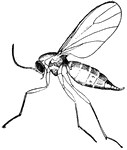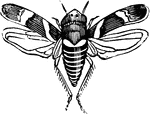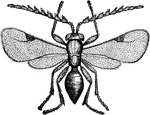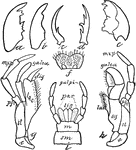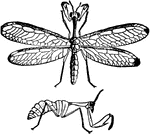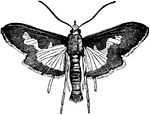
Crane Fly
Large flies with many-jointed, slender, thread-like antennae and scarcely shorter maxillary palpi.
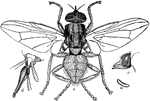
Horn Fly
This insect derives its common name from the fact that it seems to prefer clustering in great numbers…

Horse Fly
The horse-flies or tabanidae, comprise another set of troublesome creatures, of medium or large…

Mouth Structure of a Horse Fly
Piercing mouth structure of a "horse-fly": the sucking lip is omitted.
Horse Fly Larva
The larvae are elongated, somewhat flattened creatures, some living in the soil, some in water, and…

Lantern Fly
Lantern-flies may be found on the under side of leaves of various plants, particularly grape, sucking…

Lantern Fly
Lantern-flies may be found on the under side of leaves of various plants, particularly grape, sucking…
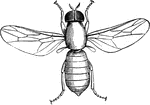
Window Fly
A small blue fly, slender and somewhat flattened in appearance, with yellow or reddish legs.

Fulgora
A most singularly-formed insect; the front part of its head being much prolonged, and projecting upward…

Geniculate Antenna
As a rule, the antennae are straight, without break from base to tip; but occasionally they are geniculate,…
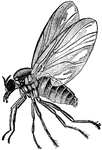
Buffalo Gnat
They are rather undersized, chunky flies, dark in color, with the thorax well developed and somewhat…
Buffalo Gnat Larva
The larva is curious little creatures, living under water in rather swiftly flowing streams, clinging…

Buffalo Gnat Pupa
The larva are curious little creatures, living under water in rather swiftly flowing streams, clinging…
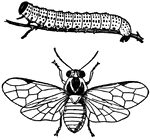
Gooseberry Caterpillar (Nematus ribesii) and Sawfly
Gooseberry Caterpillar is the name applied to the larvæ of two different insects, both injurious to…

Grasshopper
A grasshopper disarticulated and separated into regions, with all the parts named; the segments of the…

Insect Crust
Section through insect crust, showing layers of chitin at c, the cellular layer or hypodermis…
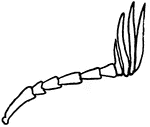
Lamellate Antenna
A lamellate feeler has at its tip a series of elongate, flattened or leaf-like joints, usually…

Mouth Parts of Plant Louse
Mouth parts of a plant-louse. -a, the jointed beak; b, the lancets, much enlarged;…
Moniliform Antenna
An antenna is moniliform, or bead-like, when the joints are more or less spherical and set…

Pickle Moth Larva
The larva of a Margaronia nitidalis on a small cucumber which had been eaten into.
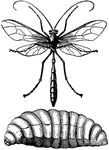
Long-Tailed Ophion
These are large or very large creatures, black or honey-yellow in color, and the bodies are transversely…

Orange Dog
The Orange Dog, caterpillar of Papilio creshontes, with osmateria, or scent organs, extended.

Pamphila Ethlius
In this latter series the fore-wings are much more pointed than in the other, and the body is proportionately…

Planthopper
Otiocerus coquebertii, a small insect of a somewhat elongated form and having a small projection in…

Plumose Antenna
When the processes become very slender, almost hair-like, and exceedingly numerous, it is said to be…
Salivary Gland
Salivary gland of the caterpillar of Melittia ceto, modified for silk spinning: mandible…




